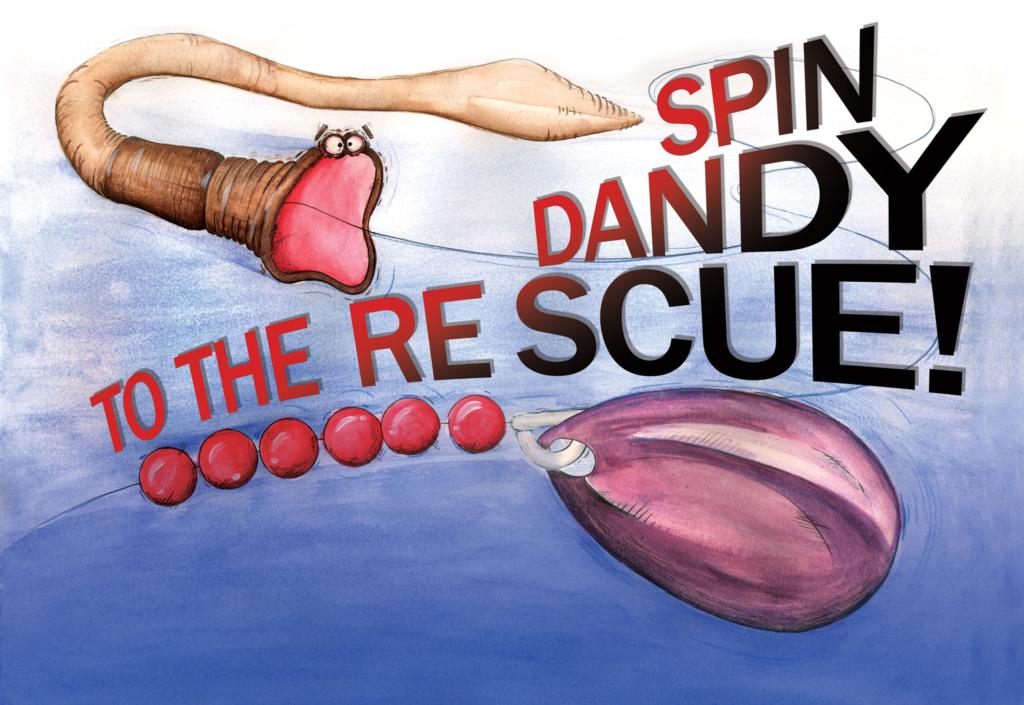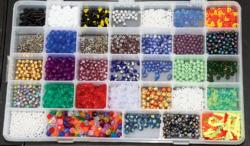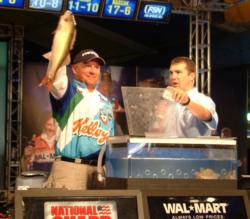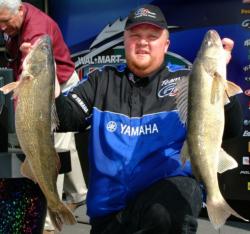Spin dandy to the rescue
Spinner-blade analysis and application

The recent expansion of big-money walleye tournaments spurred a whirlwind dispersal and refinement of fishing techniques. Traveling anglers rapidly discovered that what often works here also works there. They often discover what catches fish in a new venue also produces when applied back home – modified in some fashion, perhaps, but still a new and exciting way to catch walleyes.
Spinner-blade fishing ranks high on this list as an old method experiencing a rebirth and revolution in design and application. What originated as a relatively straightforward system for trolling bait near bottom has evolved into a flashing, whirling, thumping presentation for all depth levels. And most notably, it is a dynamic way to catch huge walleyes suspended in open-water environments.
We visited with two spinner experts to get their insights on spinner design and use for walleyes. While they share many views, their opinions also reflect how individual perspectives and confidence arise when trolling spinners on diverse waters. Rather than trying to rationalize these differences, it’s best to accept that fishing is a highly individualistic sport where presentation styles often diverge, even when fishing on the same body of water.
First up on our list is FLW Outdoors pro Nate Provost, a big-water guide and expert troller from the northern end of Green Bay, where he plies the Bays de Noc area of upper Michigan in quest of walleyes, salmon and trout. Following his input, we’ll gain insights from Scott Steil, a Minnesota-based walleye guide known for his ice and open-water fishing expertise on Mille Lacs Lake – experience he also applies on the Wal-Mart FLW Walleye Tour.
Because these are in-depth topics, we chose to give the podium to the pros and let them detail their own spinner-blade intricacies.
“When open-water trolling, if fish have been there recently, I figure they’ll likely be in the same area for a while,” Provost said. “If so, they have to be somewhere between the top and the bottom, which is how you have to search for them until you establish a productive depth level. People who fish an area all day without catching walleyes are probably fishing the wrong depth in the water column.
“A surprising amount of the time, you need to place your baits within a foot or two of the right zone. But to play it safe, I always run one rod with a spinner right down at the bottom. It may not produce numbers, but catching one or two big ones can make a huge difference in a tournament.
“When fishing spinners, it’s essential to adapt to what fish want on any given day. My favorite blade is a Colorado – although sometimes Indianas are better. Big-bladed willow-leaf or hatchet blades can be trolled faster to cover more water.
“In cold water, I usually start with smaller blades – 4s and 5s – when walleyes are biting well. Then I’ll go substantially bigger to determine if they’ll still hit it. Big blades trigger big fish. I occasionally use flashers and attractors on the Great Lakes, such as on Saginaw Bay. The rest of the time, blades provide all the attraction you need.
“During a mayfly hatch, I go down a lot on blade size,” Provost said. “You can still catch fish during a hatch, provided you use a smaller size. I always try to match the hatch as to what fish are eating – not just in color, but in size.
“In spinner fishing, little things make a big difference. You’d be surprised how often two harnesses can have virtually identical components – the same beads, hooks, etc. – but the one with a white blade and two red dots catches more fish than the plain white one. I’m continually experimenting with different colors of blades, reflective blades, airbrushed patterns and just plain weird colors. You’ll see custom blades at almost any sport show painted to match smelt or alewife patterns. Pick up a few and try ’em.
“When first testing a new body of water, golds, silvers and coppers always seem to produce a couple fish for me. Catching a few fish establishes confidence and a starting point. After that, I try to dial in a spinner program and fine-tune it for the right-size slot fish, big fish or for a charter party, depending upon the circumstances. I tell my charters to remember which blades caught the biggest fish versus the most fish. What produces big fish is often different than what works for smaller ones.
 “I tie my harnesses with 12-pound-test Trilene XT, a tough line that withstands the wear and tear of spinner rotation and fighting big fish,” Provost continued. “I tend to use clear line when trolling up high near the surface and low-vis green when fishing lower, near bottom. It’s an abrasion-resistant line that you can fish around zebra mussels, and it is heavy enough that you can catch several fish and still bring in a big fish without worrying about break-offs. If the bite gets tough or I’m in a tourney situation where one big fish is needed, switching to Vanish fluorocarbon can make a difference, however.
“I tie my harnesses with 12-pound-test Trilene XT, a tough line that withstands the wear and tear of spinner rotation and fighting big fish,” Provost continued. “I tend to use clear line when trolling up high near the surface and low-vis green when fishing lower, near bottom. It’s an abrasion-resistant line that you can fish around zebra mussels, and it is heavy enough that you can catch several fish and still bring in a big fish without worrying about break-offs. If the bite gets tough or I’m in a tourney situation where one big fish is needed, switching to Vanish fluorocarbon can make a difference, however.
“I use Quick Change clevises on my spinner snells, which enable me to change blades throughout the day. I’ll even play with different clevis colors – black, yellow, red – and even harness length, too. I always add a barrel swivel at the end of my harnesses to eliminate line twist.
“I play with hook colors a lot, too. Quite a few guys use red hooks, figuring fish target the hooks, resulting in better hooking. I use Eagle Claw fluorescent-orange hooks in tandem with silver blades more than I use standard bronze or black hooks. I experiment with green, blue and have done really well with glow hooks in deep water. I flash them with a light to make them glow before sending them down.
“I experiment with hook sizes and placement when trolling open water and will use bigger octopus or trebles if I can get away with it. Bigger hooks usually mean better hooking, especially for big walleyes. By far, my best luck is positioning two hooks a couple inches apart. For big, open-water fish, I tie a No. 2 or No. 4 single up front and a treble on the back.
“When I go spinner fishing, I probably carry 300 pre-tied harnesses wrapped around kids’ swim noodles. I’ll have eight to 10 of each desired harness-bead combo tied up and then change blades until I determine just the right combination for the day. In open water, I like to use as long of a harness as possible and still be able to net fish and not snag zebra mussels near bottom. Placing floats in between beads in the harness creates a bigger target and simultaneously keeps the harness up and out of algae, rocks and zebra mussels. It’s a good trick that will save you lots of cut-offs.
“When fishing spinners behind bottom bouncers, I typically prefer regular, dull, lead-color bouncers, but I’ve tried bright colors like orange, chartreuse and gold in dirty-water rivers,” Provost said. “They’re great for fishing on or near bottom. I also use bouncers when trolling for fish suspended around humps. Most of the time, I might be trolling 6 feet off bottom, but occasionally hit bottom during the trolling path. The bouncer skips over the rocks and goes back to running off bottom once you clear the hump.
“When I troll snap weights with longer leads, I might go up to 50 feet between my snap weight and spinner snell if the fish are spooky. If not, you can go shorter for better lift-drop action. When using a bouncer, though, about 6 feet of snell is right. Any longer and you’ll tend to snag bottom.
“I vary trolling speed a lot, anywhere from .5 to 1.5 mph. I use S-shaped movements of the boat to speed up, then slow down and drop the spinners. Using planer boards on a spread catches a lot more fish. When I’m fishing charters, I’ll typically have four Church Tackle Walleye Boards out on each side of  the boat, and I’ll bet the outer boards catch 80 to 90 percent of the fish. I believe walleyes get spooked out to the sides of the boat, and by reaching way out to them, you catch more fish.
the boat, and I’ll bet the outer boards catch 80 to 90 percent of the fish. I believe walleyes get spooked out to the sides of the boat, and by reaching way out to them, you catch more fish.
“When it’s really calm, I use my Minn Kota AutoPilot electric trolling motor for stealth,” Provost said. “It steers by compass bearing, and you can set it to run where you want while you retie knots or net fish.”
Spinner tips Steil style
“I’m an old guide who grew up live-bait rigging for walleyes,” Scott Steil said, “but the fact is, you quickly become a troller when you fish tournaments. I tend to think of them as crankbaits and to fish them like crankbaits. I used to only fish spinners on bottom with bouncers, but I now fish spinners much faster and higher in the water column. They produce on all lakes for bigger fish.
“Early in the year, 50 degrees is about the beginning of the spinner-crawler bite. Prior to that, 45 to 50 degrees is a transition period where crankbaits begin giving way to spinners. After the transition, I tend to use spinners all summer long.
“I’ll use a bottom bouncer or 2-ounce weight for bottom huggers. In many cases, however, the majority of the larger biters are suspended. If so, I’ll fish higher in the water column and use bigger baits – for example, I’ll fish 5 feet under the surface, as opposed to 20 feet down over 30 feet of water.
“Great Lakes anglers often fish for high fish, but on inland waters, few folks realize walleyes can be anywhere from the bottom to the surface. When fishing Mille Lacs along the edge of mud, for example, I’ll run one spinner with a 1-ounce sinker 30 feet back of the board for mid-depth fish; one with a 2-ounce sinker 53 feet back, right on bottom; and another spinner 40 feet back of the board with no  weight, keeping it right up near the surface. Yes, you do catch fish high on Mille Lacs, and the cardinal rule is that you never want to fish under walleyes. If anything, always err on the high side. They’ll come up for a bait, but ignore one that runs below them.
weight, keeping it right up near the surface. Yes, you do catch fish high on Mille Lacs, and the cardinal rule is that you never want to fish under walleyes. If anything, always err on the high side. They’ll come up for a bait, but ignore one that runs below them.
“I probably use a three-hook harness about 90 percent of the time,” Steil said. “Close to the blade, I like a No. 4 single hook to hook on the crawler. The middle hook is a No. 2 Gamakatsu and is the hook that catches the most fish. The last hook is a No. 8 treble stinger hook that is important when the fish are striking short. Sometimes I even put a hook ahead of the spinner blade if I’m getting bites but not hooking up, like when fish appear to hit the blade rather than the harness. That’s a little trick few anglers know.
“I generally start out with No. 4 deep-cup Colorado blades on my harnesses. As I troll along, I might begin mixing in hatchet blades for a whole different vibration. In my experience, you usually don’t catch fish on both; it’s one or the other.
“In tournaments, you don’t have a lot of time to establish patterns, so you pull what you have confidence in. In clear or stained water, 90 percent of the time I’m trolling purple, gold or combinations thereof. It might be standard smooth blades. It might be hammered finishes. Northland Fishing Tackle has great baitfish patterns with purple blending into silver and gold baitfish. On cloudy days, I might use firetiger with chartreuse greens in baitfish patterns size No. 4 and 5. If the fish are big and the bite dies, I will pull up to a No. 7 blade to trigger big bites with a big thump. You can experiment and use what works.
“When the water is cold early in the year, I pull spinners at about .8 to 1.2 mph. Later in the year, I’ll run 1.2 to 1.8 mph, the same as cranks. It can still be finesse-type fishing, but you can cover a lot of water. Sometimes I’ll pull crankbaits in tandem with spinners and experiment with speed, turning back around on a bite to cover the school of fish.
“I find trolling either fast or slow works best – but not both. I like to use a stop-and-go pattern on calm days to make the bait flutter and rise. Wave action on windy days imparts action and changes speed on its own, however, so you don’t have to vary speed on your own.
“I use Berkley Vanish to make my spinner harnesses, as well as on my main line – 14-pound test on my harnesses and 12-pound test on the reel,” Steil said. “I’m a big believer in using fluorocarbon’s invisibility to avoid spooking walleyes in clear water. It’s also super abrasion-resistant, and I have no trouble with break-offs or knots. I don’t even use mono anymore when fishing spinners. Vanish has just the right amount of stretch. It’s not nonstretch and not super stretch. It’s just right.”
Home-spun wisdom
What surprised me most about the pros’ shared experience was that neither Provost or Steil talked  much about Indiana blades. They instead rely upon wide Colorados for thump at slower speeds; willow leafs for flash at higher speeds; and hatchet blades in between for a bit of irregular vibration. Intermediate-shaped Indianas all but fell out of the equation. Also, there was no mention of using premium silver-plated blades for maximum flash – a common investment by many walleye pros for use in open water. Instead, they match their colors and patterns to forage types, water color and sunlight penetration. Most of all, they constantly experiment with combinations of components to see what works best.
much about Indiana blades. They instead rely upon wide Colorados for thump at slower speeds; willow leafs for flash at higher speeds; and hatchet blades in between for a bit of irregular vibration. Intermediate-shaped Indianas all but fell out of the equation. Also, there was no mention of using premium silver-plated blades for maximum flash – a common investment by many walleye pros for use in open water. Instead, they match their colors and patterns to forage types, water color and sunlight penetration. Most of all, they constantly experiment with combinations of components to see what works best.
In effect, spinners aren’t just for bottom bouncing anymore. Going top to bottom and side to side, they trigger strikes via a combination of flutter, flash, vibration and profile that’s judged good enough to eat by the biggest walleyes in the lake. If anything, spinner fishing in open water is a new frontier for average anglers, following and reaping benefits from the trailblazing efforts of tournament pros. It may, in fact, be the single greatest frontier left to explore by future walleye pioneers.
For more information on Nate Provost’s guide services, visit upprocharters.com or call (906) 235-0686.
To contact Scott Steil’s guide service, visit scottsteilfishing.com or call (320) 293-3287.
